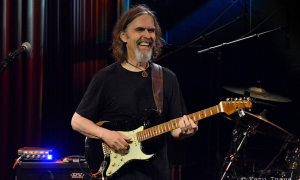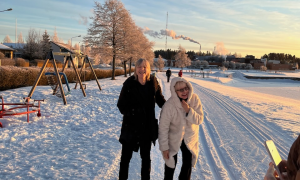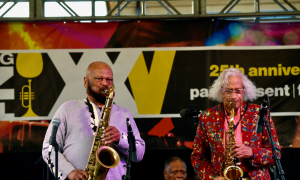Home » Jazz Articles » SoCal Jazz » Dennis Chambers: Heartbeats and Backbeats
Dennis Chambers: Heartbeats and Backbeats
DC: Yes, he is a very genuine and giving person to be around. Carlos listens to a lot of music, a lot of different types of music. He would hear something he liked and it would inspire him to incorporate a sound or an idea into his music. It wasn't unusual for him to bring us these changes and want to incorporate them into our shows right away. Like that night! That can be difficult and puts a lot of pressure on you.
AAJ: High enthusiasm with high expectations. No matter what type of music you are playing, you bring an enthusiastic vibe and also play with a lot of feeling. Do you think that not reading music has been beneficial in playing what you feel instead of reading?
DC: There's something to that. But then look at a cat like Steve Gadd. He is a phenomenal reader. But he plays it with a lot of feeling. You could take three or four drummers that will read the music and play it note for note. It will sound exactly the same. Gadd and Vinnie Colaiuta, and a few others, can read that chart and still get that feeling across.
AAJ: They manage to put themselves into it.
DC: Yes, very much so.
AAJ: Buddy Rich didn't read music and many people have thought he was the G.O.A.T.[Greatest Of All Time], including himself.
DC: (laughing) Including himself. (laughing).
AAJ: Well, since we are talking about drummers. You can surely feel the Elvin Jones and Billy Cobham presence in your playing. Who else are/were your biggest influences? The incomparable Tony Williams would have to be another.
DC: Yes, of course, to all of them. Also Art Blakey, Roy Haynes, Max Roach, Alan Dawson, Louie Bellson, Rich, David Garabaldi from Tower of Power, and soul drummers like Al Jackson (a founding member of Booker T & the MG's), Zigaboo Ziggy Modeliste from The Meters, Melvin Parker, and of course Clyde Stubblefield (Parker and Stubblefield were both drummers for James Brown).
AAJ: That's an impressive and diverse list. The Cobham power and grooves seem to flow right through you.
DC: I'll tell you a Billy Cobham story. I saw him play with Horace Silver back in the late sixties at a jazz club here in Baltimore called the Left Bank. Then I saw him again with the Mahavishnu Orchestra in the early seventies. I couldn't believe it was the same guy. I mean, he looked different, he was playing way differently. I refused to believe it was the same guy. I thought it was a look-alike.
AAJ: Yeah, well and McLaughlin too. He didn't look like the same cat that played with Miles on Bitches Brew (Columbia, 1970) and Jack Johnson (Columbia, 1971).
DC: Well, the thing about Mahavishnu that amazes me is that in a three-year period they changed everyone's perspective. They opened up a gateway. Let's face it, before they came along nobody played like that. Nobody. Tony Williams Lifetime was exceptional.. But it was more long jams. McLaughlin took everything he had learned up to that point, including working with Tony as part of Lifetime, and poured it into Mahavishnu. They certainly stretched out when they played live, but there were songs there that had classical touches and were just deeply composed and arranged. Then too, nobody had played the guitar or the drums like John and Billy. It changed the face of music. Yet they aren't inducted to the Hall of Fame. What's up with that?
AAJ: Well, that's one of those don't get me started conversations, kind of like the Grammys.
DC:. Oh yeah, that's become something about who can wear the least amount of clothes or something like that.
AAJ: Sad but true. So moving on, is it true that your name was brought into the conversation should Led Zeppelin have continued without John Bonham?
DC; No, what happened was that Bonham's son, Jason, had done an interview with Modern Drummer. He was asked that if his father wasn't the drummer for Led Zep is there someone else that you think could replace him or do a great job with Led Zep. He then mentioned my name.
AAJ: Oh, I see. I'm a big fan of Zeppelin. How about you?
DC: Oh yeah, definitely. They had so many great songs and Bonham had a lot of soul in him. He definitely had listened to a lot of black drummers. His idols were guys like Alphonse Mouzon and Bernard Purdie. He listened to a lot of blues stuff.
AAJ: Well, Led Zeppelin was heavily blues based, covering old Willie Dixon tunes, as well as many others that weren't credited, and just the whole blues feel being heavied up.
DC: Exactly right, man. They were into soul and black artists. In fact there is a song called "Foolish Fool" that is responsible for part of Led Zep's sound. A blues tune. Check it out.
AAJ: That's interesting. I will definitely check it out.
DC: Those guys grew up listening to the blues. Bonham told me that they listened to two radio stations that were being piped into London, which was being bombed out at the time. The BBC and one other station where at a certain time of night they played the blues. He along with Jimmy Page and Eric Clapton and the guitarist for The Who...
AAJ: Peter Townshend
DC: Right, yeah, Peter Townshend...would all be in to that. Page was the younger of that group of guys and I found out later that John McLaughlin was one of his teachers. I found that out when I was working with John. The first rehearsal I had with John was in London. Right next to us in the next studio was Jimmy Page. Jimmy was freaking out that John was next door, talking all about how he was his teacher, and this story, and that story, and all that. I just hear him saying these things and I don't know yet who he is. I didn't recognize him because he had his hair pulled back in a bun and just looked way different. Big head and small body (laughing). This is while we are on break and John was still in the studio going over some things with Joey (DeFrancesco). I finally figured out who he was and went over and introduced myself and told him I was John's drummer. I asked him if he would like to see him. He was like "oh yeah, definitely." Excited about it. I went back in the studio. John was busy showing Joey some chords. I interrupted for a moment to tell John that Jimmy was there and that he would like to say hello. He was a little surprised, "Jimmy's here?" I said, "yeah, he's right outside the door." He said some stuff messing about that I won't repeat here (laughing} and I went back out. I left for just a little while and when I came back Jimmy is still standing outside the door. "Did he come out?," I asked. "No" says Jimmy. So I went back in and told John that Jimmy was out there waiting for him. So John finally goes out and Jimmy grabs him up with a big hug, so happy to see him. John was taken aback a little in the moment, that Jimmy was so ecstatic to see him. Mind you John was happy to see Jimmy too, but there was just this whole different vibe going on. Anyways, to make a long story not quite so long, they ended up having some laughs and telling old stories. What I want to get to is that after John went back in the studio I asked Jimmy why he was there, you know, what he was working on. He said he was going on tour with Robert Plant and he just came by to pick out an amp. He said he had a bunch of them and a lot of other stuff there in storage. So I asked if I could see, could have a look. He opened the door and at the door all the way down to the stage, across the stage, back down the other wall, and back towards me, amps. A lot of stuff with Led Zeppelin on it, stuff with Yardbirds on it.
AAJ: Oh man, that's very cool. Amp history, amp paradise.
DC: Yeah, Marshall amps, all these really nice cabinets. Yeah, its like the whole history of the Yardbirds and Led Zep.
AAJ: That's a cool story. You did later get into some powerful stuff with your band Niacin. Teaming up with ostensibly a rock bassist, Billy Sheehan and keyboardist John Novello. Sheehan mostly known for playing with hard rock band Mr. Big. I was going to say that you did three or four albums, but it's more than that right?
DC: Yeah, like probably twice that.
AAJ: Unlike most fusion it really pushes the rock edge and you and Sheehan form quite the power rhythm section for an organ trio. Then, of course, there is CAB. Another band with a completely different sound. Tony MacAlpine shows a whole different side in this fusion equation. I have noticed with all of those albums that bassist Bunny Brunel is the primary songwriter. Was CAB his idea, is he the leader, driving the CAB?
DC:. That's Bunny. CAB is his idea, yes.
AAJ: I like the diversity of structure in CAB. Later bringing in Brian Auger to contrast his keys with Tony Mac.
DC: Also Patrice Rushen played on some CAB tunes.
AAJ: Oh yeah, that's right. Part of that diversity. Her keys channeling a different set of emotions than Auger's. So you still live in Baltimore, correct? You have lived there your entire life.
DC: Yes. Actually I live in Randallstown, but I usually just say Baltimore.
AAJ: A suburb, yeah. I know I have seen listings for a club called An die Musik, which is a piece written by Franz Schubert, in Baltimore. Not too far back you were playing with Leni Stern and Tom Kennedy. I remember thinking, 'man, I wish they would play out west or I wish I was there. I would think that must have been a fun show.
DC: Yes, Mike played too. Yeah, it was fun. We also have the Keystone Korner. A club that Renee and I have been to many times. We just went and saw Sco play there. I have seen many great artists play there. Every month they have somebody major coming through there. I saw Ron Carter not too long ago. I have seen him a few times. I have seen Kenny Garrett. The The Headhunters have been there. I saw Lenny White with Patrice Rushen. I will be playing there soon with Mike and Randy Brecker.
AAJ: Then it must be right after that when you start your tour with Oz Noy and Jimmy Haslip. Where all will you be playing?
DC; It's a small tour. Let me get my calendar out so I get the dates right. We start in Denver on March 15th. Then Chicago on the 16th and Moline, Illinois on the 17th. Let's see, March 18th in Cleveland, the 19th in Milwaukee, and then the 21st in Nashville. We'll be in Admore, Pennsylvania on the 22nd. Then we head west. March 24th in Oakland and March 25th and 26th in Los Angeles. Up to Portland on the 27th and that's it.
AAJ: Nice. I wasn't counting, but about a ten-show run.
DC: Yeah, something like that.
AAJ: Well, we've been talking for ninety minutes, I should probably let you go. Thanks very much, Dennis. I appreciate your time and very much enjoyed the conversation.
DC: Yeah, man. Good talking with you.
AAJ: See you in L.A. Looking forward to hearing and seeing you play with Oz Noy and Haslip.
Tags
PREVIOUS / NEXT
Dennis Chambers Concerts
Jan
30
Fri
Jan
30
Fri
Jan
31
Sat
Jan
31
Sat
Feb
1
Sun
Feb
1
Sun
Support All About Jazz
 All About Jazz has been a pillar of jazz since 1995, championing it as an art form and, more importantly, supporting the musicians who make it. Our enduring commitment has made "AAJ" one of the most culturally important websites of its kind, read by hundreds of thousands of fans, musicians and industry figures every month.
All About Jazz has been a pillar of jazz since 1995, championing it as an art form and, more importantly, supporting the musicians who make it. Our enduring commitment has made "AAJ" one of the most culturally important websites of its kind, read by hundreds of thousands of fans, musicians and industry figures every month.























